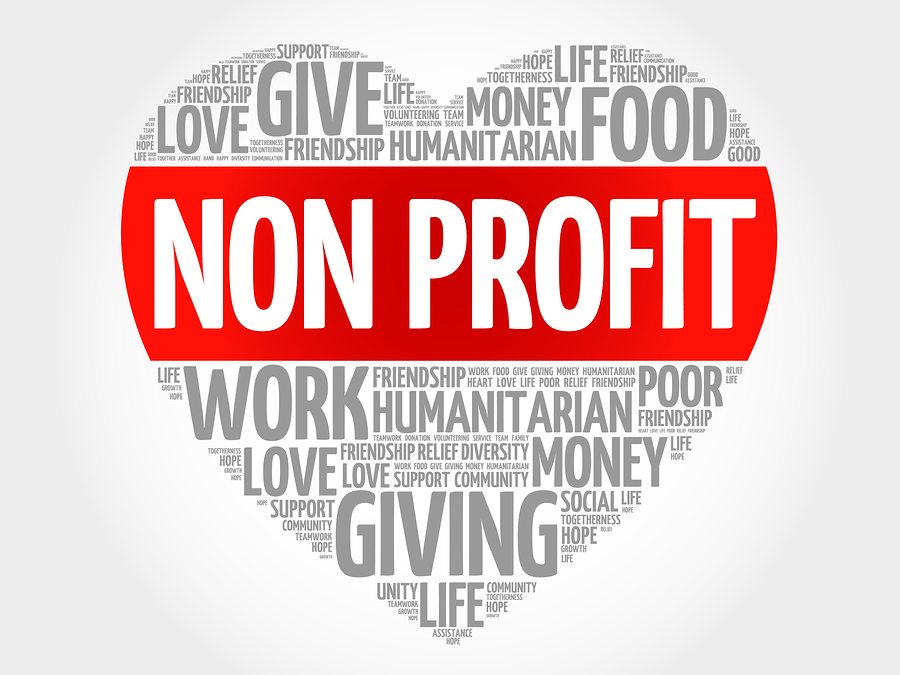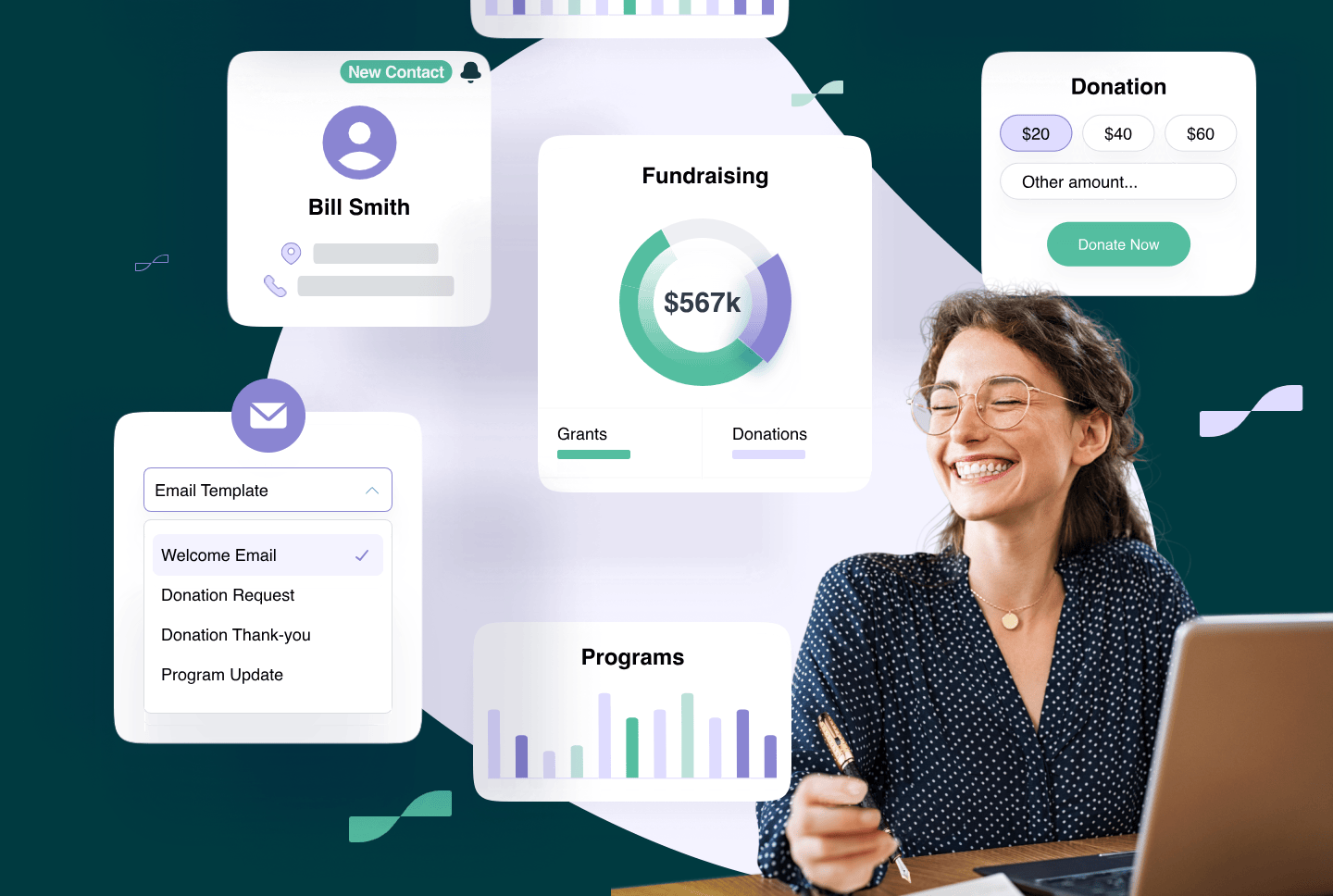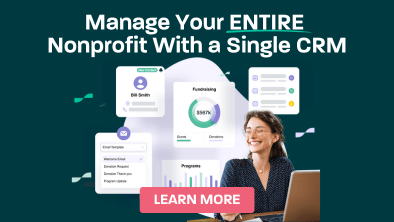If you have ever thought about starting a nonprofit organization then this guide is for you! We’ll cover the basics of how to start a nonprofit, including the nonprofit definition versus the charity definition.
This guide includes the laws and regulations for Canada and the United States, the importance of data security, as well as an overview of marketing and fundraising basics for you to get started with growing your new nonprofit organization!

Charity Definition and Nonprofit Definition
Many people will use the terms nonprofit and charity interchangeably, but the charity definition and the nonprofit definition are different in a few key ways. Charities are a subsection of nonprofit organizations which are registered with the government and have regulations they need to follow, in turn they receive certain advantages from being registered charities.
All charities are nonprofits, but not all nonprofits are charities, so you’ll need to decide which one your new organization is going to be.
Charity Definition
- Cannot serve private interests
- Cannot be “profitable” or have shareholders
- Cannot use its income to benefit members
- Are exempt from paying income tax and some other taxes
- Donations to these organizations can be deducted during tax filing
For information on registered charities in Canada, see the CRA (Canada Revenue Agency) website. For more information on 501(c)(3) organizations see the IRS (Internal Revenue Service) website.
Pros
- Tax exemptions
- Eligible donations are tax deductible
Cons
- Must meet the requirements
- The advocacy and engagement these organizations can have with government is limited
- For many organizations this won’t be an issue, but for organizations that wish to influence policy to push their mission forward this is an obstacle
Nonprofit Definition
As the term nonprofit is an umbrella definition that includes charities there is some overlap with the charity definition.
- Cannot serve private interests
- Cannot be “profitable” or have shareholders
- Cannot use its income to benefit members
- Are not tax exempt and donations are not deductible
This resource from the CRA is applicable to Canada only, but it provides a good breakdown of the difference between the charity definition and nonprofit definition.
There are pros and cons to being both a registered charity or a nonprofit organization.
Pros
- Free to engage in advocacy and attempt to influence legislation
- Claim being an independent organization that doesn’t take government money or have to follow the registration regulations
- This will appeal to some donors and will work well for certain missions and causes
Cons
- Donations are not eligible for tax deduction, some people may not donate just for that reason
- As the general public doesn’t really understand the difference, they may not even realize until afterwards that their donation isn’t deductible and they may be upset with your organization
- Eligibility for grants
- Certain grants will be for registered charities only so your nonprofit won’t be eligible to receive them
In most cases you are going to want to register your nonprofit as a charity, because of the benefits that charities receive from the government. However, there are some cases where being defined as a nonprofit is actually more beneficial to your mission.
A well known example of a nonprofit is Greenpeace, neither the USA branch or the Canadian branch of this organization are registered charities, instead they are registered as nonprofit organizations. Operating as a nonprofit, and not a registered charity, gives Greenpeace freedom to engage in lobbying and influence legislation which is at the core of its mission.
How to Start a Nonprofit: Incorporating and Registering as a Charity
Once you know the difference between a nonprofit and a registered charity, the next step in forming your new nonprofit organization is to consider incorporation and register as a charity, if you plan to apply for charitable status.
Incorporating
While it is possible to start a nonprofit, and register as a charity or 501(c)(3) without incorporating, it is a good idea to incorporate your nonprofit organization. You should consider incorporating your nonprofit organization as it offers you limited liability coverage, among other benefits and protections.
In Canada, you can incorporate at the federal or provincial level and depending on your organization you may need to incorporate in both your province and federally. You can find information here on how to incorporate a nonprofit in Canada.
In the United States, you can incorporate within the state, or states, of your nonprofit’s operations. The National Council for Nonprofits has more information about how to incorporate a nonprofit in the United States.
Registering as a Charity
In Canada, once you have formed your nonprofit organization you can apply for charitable status. To complete the application you will need to give information about your charitable activities, including a plan for what you want to achieve and how and whether you will be conducting your charitable activities outside of Canada.
You can find more information on how to apply as a charity in Canada on the CRA website.
In the United States, to apply for 501(c)(3) status, you need to fill in a Form 1023-series application. You can find information about the Form 1023-series application on the IRS website. For more information about applying to 501(c)(3) status the IRS has helpful resources like this FAQ page and even an online course.
Your Unique Mission
If you’re thinking about starting a nonprofit, then you probably already have a mission, or a cause, in mind. There is a lot of competition in the nonprofit sector, so when you’re starting a nonprofit it’s really important to have a clear idea what your mission is and what sets your organization apart from others.
Consider what about your organization will make it stand out among the others. Will you be offering a different service or program than another organization, for example if you want to help people fighting cancer, will you be funding research or providing local support to patients like driving people to appointments and providing support to them and their families?
The first step in how to start a nonprofit, after understanding what a nonprofit is, is having a clear idea about your unique mission.
Getting Started With No Money
Is it possible to start a nonprofit with no money? Yes…and no.
There are fees involved with setting up your nonprofit like fees for incorporation and for registering as either a charity, in Canada, or as a 501(c)(3) organization in the United States. So, you will need money to pay for these fees as well as some other expenses you’ll have when you get started like setting up your website.
Then, of course, there’s the money you’ll need to start delivering your programs or services.
The good news is that it is possible to start a nonprofit without using any money of your own. You can apply for grants to secure the funds you need to get started or do some fundraising in your neighborhood or online with crowdfunding.
Data Regulations and CRM Software
When you’re starting a nonprofit, CRM software may be lower on your list, after all when you’re just getting started you may not have many contacts. However, your nonprofit’s data is very important and will be its greatest tool for growth. It’s important that you keep it organized, and secure.
Data privacy and security is serious and your nonprofit is going to be bound by the privacy and data protection laws of your country or state. Canada has national laws which govern privacy rights and data storage. In the United States privacy laws are set by the states and vary from state to state. A key part of how to start a nonprofit is getting funding either through grants or from individual donors. And with these donations comes personal information from these donors that you’ll need to keep track of and keep safe.
Beyond donors, you may have data from volunteers, staff and even from clients that your nonprofit is serving. You do not want to be keeping this sensitive information in an excel document saved on your computer hard drive! It needs to be organized, and secure, in a nonprofit CRM like Sumac.
Don’t make the mistake of starting a nonprofit without a CRM, even if you could get away without one, later on when you need one it’s going to be a lot of work to make the switch.
You are probably asking “But isn’t CRM software expensive? How do I start a nonprofit with no money for a CRM?”
As a new nonprofit you can pay as little as $35month.
Starting out with a CRM like Sumac CRM is going to benefit your new nonprofit so much, and when you’re ready for more, Sumac CRM offers so many features and add-ons, you can completely customize it to your needs as your nonprofit continues to grow.
Marketing Basics for New Nonprofits
When you start a nonprofit organization marketing is really important because this is how people are going to find out about your nonprofit and its mission. Simply put, you need people to know that your nonprofit exists, and marketing is how you tell them!
Website
When you start a nonprofit organization you’re going to want to set up a website as that is one of the first places people will want to go to learn more about your nonprofit. Building a website sounds intimidating, but it doesn’t have to be!
You can use a website builder like Squarespace or Wix to build your nonprofit’s website and as it grows you can add more features and build a more sophisticated website. Once your website is done, consider Google’s Ad Grant Program for Nonprofits.
Branding Basics
When you start a nonprofit organization building your organization’s brand is the core of your marketing efforts. Your brand goes so much further than just your logo and nonprofit name, it also includes:
- The type of language you use and how you address your audience
- Your organizational tone, for example being more casual with the way you communicate or more formal in your language
- The style of photography that you use
- Your fonts and colours including secondary or accent colours
These things may seem small, but they all add up to a recognizable brand that people will know when they see your marketing materials and posts before they even see your nonprofit’s name or logo.
Social Media
Social media and digital marketing are the easiest entry point for nonprofit marketing and you can build an audience organically fairly quickly without needing to spend any money.
There are so many social media channels out there, to get started you’ll probably want to start with the main ones:
As you grow your audience and learn what type of social media content works for your nonprofit you’ll be able to figure out which channels you should dedicate most of your marketing time to. And you can expand to other social media channels like:
- YouTube
- LinkedIn
- While you may want to wait on rolling out a complete LinkedIn marketing strategy, you should set up a LinkedIn company page for your new nonprofit organization
Getting Started With Fundraising
Nonprofits earn their money from donations from individuals, as well as grants from foundations and government and other revenue streams like corporate sponsorship. There are many fundraising streams that your nonprofit can use to generate revenue.
Grants
Grants are funds that your nonprofit can receive from government, foundations, and other sources.
- Grants typically have an application process
- Most grants will have specific requirements for your nonprofit to be eligible
The nonprofit grant applications process is highly competitive so make sure your nonprofit applies to all the grants it’s eligible for to increase your chance of receiving funding. Read: How to Write a 2 Page Grant Proposal (With Templates).
Corporate Sponsors and Partners
When you are figuring out how to start a nonprofit and working with corporate partners, you need to be aware of the rules for issuing tax receipts for donations from corporations and what counts as a donation versus a sponsorship.
- Corporations can make donations to your organization and receive the tax benefits from the gift
- They can provide grants and other forms of funding through their corporate foundation.
- Corporate partners can offer you a sponsorship in return for recognition
- Sponsorship is not a donation and is a form of advertising as the sponsor receives naming and logo placement and other valuable benefits. Sponsorships are not tax deductible
Individual Giving
Donations from individuals are going to be key when you’re starting a nonprofit. Donations from individual donors can range from a $50 annual gift to a gift of several thousand dollars, larger gifts are often referred to as major gifts.
- Individual donors who are making smaller contributions are typically solicited by mass marketing means like direct mail or telefundraising
- Don’t overlook these small donors who give $20-50 at a time as they can become your most loyal supporters and their lifetime value is beyond a couple dollars here and there
- Major donors need to be stewarded and solicited slowly, you need to make a clear case for the amount of money you’re asking for
- Make sure you have a monthly giving strategy as these recurring gifts will provide reliable revenue to your nonprofit
There are many resources to help you learn about fundraising and all of its forms, including the Sumac blog!
You’ll also find resources for fundraising from the Association of Fundraising Professionals (AFP), which will be a great resource to you and your team for growing your revenue as you learn the ropes.
Starting a nonprofit organization is a lot of work and there’s a lot of information to learn about how to start a nonprofit. Use this guide as a starting point and draw up a roadmap for your new organization. And don’t lose sight of your mission to make the world a better place!


